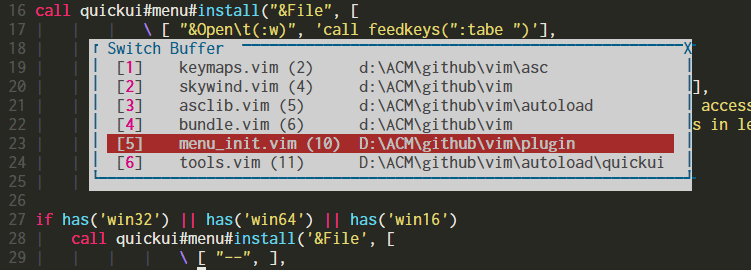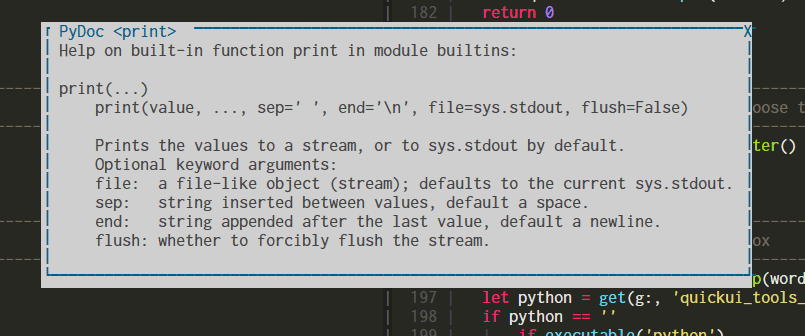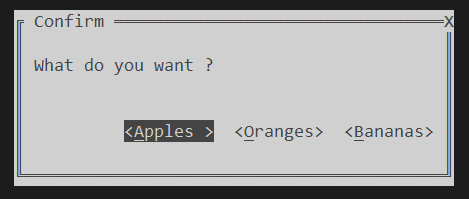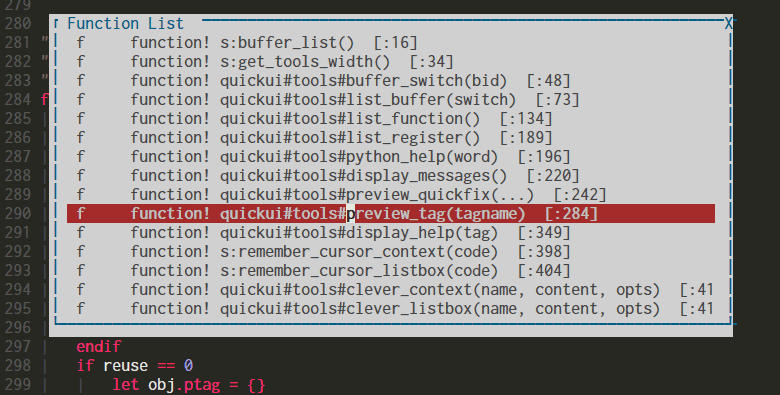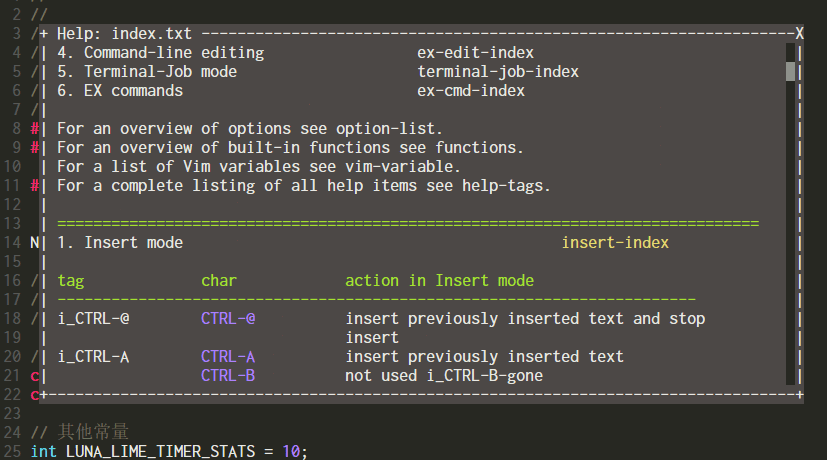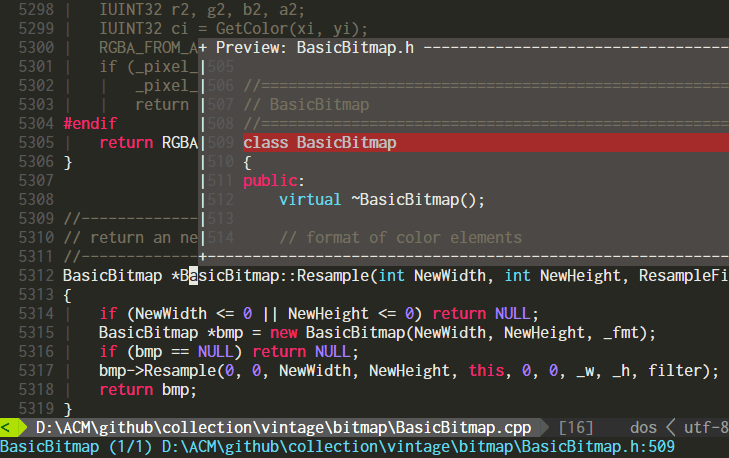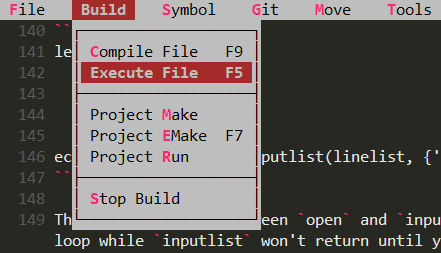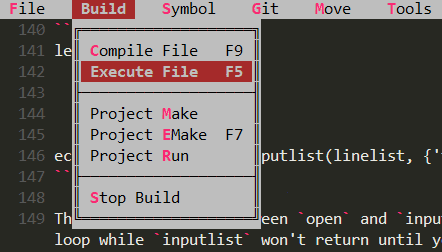QuickUI is fully customizable, and can be easily configurated.
- Vim: 8.2 or later.
- NeoVim: 0.4.0 or later.
Plug 'skywind3000/vim-quickui'
Display a dropdown menubar at top of the screen:
Usage:
h/CTRL+h/LEFT: move left.l/CTRL+l/RIGHT: move right.j/CTRL+j/DOWN: move down.k/CTRL+k/UP: move up.SPACE/ENTER: confirm.ESC/CTRL+[: cancel.H: move to the left-most menu.L: move to the right-most menu.J: move to the last item.K: move to the first item.
Note: hjkl may be overried by user hotkeys, so CTRL+hjkl or arrow keys can be used at all time.
APIs:
register menu entries:
call quickui#menu#install(section, items [, weight [, filetypes]])display the menu:
call quickui#menu#open()Sample code:
" clear all the menus
call quickui#menu#reset()
" install a 'File' menu, use [text, command] to represent an item.
call quickui#menu#install('&File', [
\ [ "&New File\tCtrl+n", 'echo 0' ],
\ [ "&Open File\t(F3)", 'echo 1' ],
\ [ "&Close", 'echo 2' ],
\ [ "--", '' ],
\ [ "&Save\tCtrl+s", 'echo 3'],
\ [ "Save &As", 'echo 4' ],
\ [ "Save All", 'echo 5' ],
\ [ "--", '' ],
\ [ "E&xit\tAlt+x", 'echo 6' ],
\ ])
" items containing tips, tips will display in the cmdline
call quickui#menu#install('&Edit', [
\ [ '&Copy', 'echo 1', 'help 1' ],
\ [ '&Paste', 'echo 2', 'help 2' ],
\ [ '&Find', 'echo 3', 'help 3' ],
\ ])
" script inside %{...} will be evaluated and expanded in the string
call quickui#menu#install("&Option", [
\ ['Set &Spell %{&spell? "Off":"On"}', 'set spell!'],
\ ['Set &Cursor Line %{&cursorline? "Off":"On"}', 'set cursorline!'],
\ ['Set &Paste %{&paste? "Off":"On"}', 'set paste!'],
\ ])
" register HELP menu with weight 10000
call quickui#menu#install('H&elp', [
\ ["&Cheatsheet", 'help index', ''],
\ ['T&ips', 'help tips', ''],
\ ['--',''],
\ ["&Tutorial", 'help tutor', ''],
\ ['&Quick Reference', 'help quickref', ''],
\ ['&Summary', 'help summary', ''],
\ ], 10000)
" enable to display tips in the cmdline
let g:quickui_show_tip = 1
" hit space twice to open menu
noremap <space><space> :call quickui#menu#open()<cr>Then you can open the menu by pressing space twice. If the 4th parameter filetypes is provided as a comma separated list, the menu will display only if the current file type can be matched in the list.
call quickui#menu#install('&C/C++', [
\ [ '&Compile', 'echo 1' ],
\ [ '&Run', 'echo 2' ],
\ ], '<auto>', 'c,cpp')This C/C++ menu will be visible only if the filetype of current buffer is c or cpp.
As we are living in multiverse, and menus can be separated in multiple namespaces too. The quickui#menu#open function can actually take one more argument like:
call quickui#menu#open('abc')If it is invoked with an argument "abc", menus in the namespace "abc" will display immediately. If this argument is omitted, the default namespace "system" will be used.
When you have hundres of items to deal with, menu is not enough to hold them. Then you will need a listbox.
Features:
- Listbox can used to pick up a item from thousands items.
- Columns separated by
"\t"will be aligned. - A scroll bar will display if there are too many items.
- Mouse wheel can be used to scroll the content.
- Character starting with
&can be used as a shortcut. - It has a title, and can be dragged by mouse.
- Search item with
/or?command. - Jump to line with
:command.
Usage:
j/CTRL+j/UP: move up.k/CTRL+k/DOWN: move down.J/CTRL+d: half page down.K/CTRL+u: half page up.H/CTRL+b/PageUp: page up.L/CTRL+f/PageDown: page down.SPACE/ENTER: confirm.ESC/CTRL+[: cancel.g: go to the first item.G: go to the last item./: search forwards.?: search backwards.:: go to line number.n/CTRL+n: next match.N/CTRL+p: previous match.
Note: hjkl or n may be overried by user hotkeys, so CTRL+hjkl or CTRL+n can always be used at all time.
APIs:
Open the listbox:
quickui#listbox#open(content, opts)Parameter content is a list of [text, command] items. opts is a dictionary of options, available options are:
title: title of the listbox.index: initial cursor position, starts from 0.w: listbox width.h: listbox height.col: screen position in columns, starts from 1.line: screen position in lines, starts from 1.color: background color, default toQuickBG.syntax: thefiletypeapply to thelistbox.callback: a function ("fn(code)"form) which will be called after listbox closed (press Enter or ESC).
All options are not compulsorily required and can be omitted. The callback function will be invoked with a parameter code which represent the selected item index. If you quit (ESC/CTRL+[) without making your selection, code will be -1.
There is an internal variable g:quickui#listbox#cursor which stores the last cursor position (index) in the listbox. It can be used to restore previous location.
Sample code:
let content = [
\ [ 'echo 1', 'echo 100' ],
\ [ 'echo 2', 'echo 200' ],
\ [ 'echo 3', 'echo 300' ],
\ [ 'echo 4' ],
\ [ 'echo 5', 'echo 500' ],
\]
let opts = {'title': 'select one'}
call quickui#listbox#open(content, opts)It can also work like inputlist() function by using quickui#listbox#inputlist, it will return the index you select immediatedly instead of executing a vim command:
let linelist = [
\ "line &1",
\ "line &2",
\ "line &3",
\ ]
" restore last position in previous listbox
let opts = {'index':g:quickui#listbox#cursor, 'title': 'select'}
echo quickui#listbox#inputlist(linelist, opts)The key difference between open and inputlist is open will return immediately to vim's event loop while inputlist won't return until you select an item or press ESC.
Prompt user to input a string in a TUI box:
Could be used as a drop-in replacement of input() function:
APIs:
quickui#input#open(prompt [, text [, history_key]])Sample code
echo quickui#input#open('Enter your name:', 'nobody')Usage:
Left/Ctrl+B: move cursor left.Right/Ctrl+F: move cursor right.Shift+Left: select left.Shift+Right: select right.Ctrl+g: select all.Up/Ctrl+P: previous history.Down/Ctrl+N: next history.Ctrl+Insert: copy to register*.Shift+Insert: paste from register*.Ctrl+K: kill all characters on and after cursor.Ctrl+D: delete character under cursor.Ctrl+W: delete word before cursor.Home/Ctrl+A: rewind cursor.End/Ctrl+E: move cursor to the line end.Ctrl+R Ctrl+W: read current word.Ctrl+R =: read evaluation.Ctrl+R {reg}: read register.
Another Sample
function! SearchBox()
let cword = expand('<cword>')
let title = 'Enter text to search:'
let text = quickui#input#open(title, cword, 'search')
if text != ''
let text = escape(text, '[\/*~^')
call feedkeys("\<ESC>/" . text . "\<cr>", 'n')
endif
endfuncYou can search text with this function without dealing with special character escaping.
Context menu imitates Windows context menu (triggered by your mouse right button), which will display around the cursor:
It is usually used to present some commands that will do something with source code in the current line.
APIs:
open the context menu:
quickui#context#open(content, opts)Parameter content is a list of [text, command] items. opts is a dictionary of options, has similar options in listbox but an additional option:
ignore_case: ignore case of the keyword, default 1.
Sample code:
let content = [
\ ["&Help Keyword\t\\ch", 'echo 100' ],
\ ["&Signature\t\\cs", 'echo 101'],
\ ['-'],
\ ["Find in &File\t\\cx", 'echo 200' ],
\ ["Find in &Project\t\\cp", 'echo 300' ],
\ ["Find in &Defintion\t\\cd", 'echo 400' ],
\ ["Search &References\t\\cr", 'echo 500'],
\ ['-'],
\ ["&Documentation\t\\cm", 'echo 600'],
\ ]
" set cursor to the last position
let opts = {'index':g:quickui#context#cursor}
call quickui#context#open(content, opts)You can define your own context menu and map it to K (override the original keywordprg command). And you will get a much more powerful K command then before.
Textbox is used to display arbitrary text in a popup window.
Features:
- HJKL to scroll up/down, ESC to quit
- Support syntax highlighting
APIs:
open textbox:
quickui#textbox#open(textlist, opts)Run a shell command and display the output in the textbox:
quickui#textbox#command(command, opts)Sample code:
" display vim messages in the textbox
function! DisplayMessages()
let x = ''
redir => x
silent! messages
redir END
let x = substitute(x, '[\n\r]\+\%$', '', 'g')
let content = filter(split(x, "\n"), 'v:key != ""')
let opts = {"close":"button", "title":"Vim Messages"}
call quickui#textbox#open(content, opts)
endfuncThis function can display vim error messages (:messages) in the text window:
Navigating the messages with HJKL or PageUp/PageDown is much handy than list them in the command line by :messages.
Preview window is used to replace traditional pedit command and can be used to display certain file in a small popup window around your cursor:
You can open the preview window by:
quickui#preview#open(filename, opts)It will not interfere your work, and will immediately close if you move your cursor around. The second parameter opts is a dictionary with options, available options are:
| Option | Type | Default | Description |
|---|---|---|---|
| cursor | Number | -1 | if you set it above zero, the certain line will be highlighted (use cursorline). |
| number | Number | 1 | set to zero to disable line number |
| syntax | String | unset |
additional syntax file type, eg: cpp or python |
| title | String | unset |
additional title for preview window |
| persist | Number | 0 | By default the preview window will be closed automatically when CursorMove happens, set to 1 to close it manually by quickui#preview#close() |
| col | Number | unset |
specify window position by column |
| line | Number | unset |
specify window position by line number |
| w | Number | unset |
specify window size by width |
| h | Number | unset |
specify window size by height |
Usually the syntax highlighting and cursorline will help you when you are using it to peek symbol definitions.
The filename argument can be provided as a list of strings, if so, preview window will display the content of the list, and syntax filed in the opts argument can be used for highlighting.
User can scroll the content in the preview window by:
quickui#preview#scroll(offset)Parameter offset is an integer, above zero to scroll down and below zero to scroll up.
The terminal widget can allow you open a terminal in the popup window:
quickui#terminal#open(cmd, opts)Parameter cmd can be a string or a list, and opts is a dictionary of options, available options are:
| Option | Type | Default | Description |
|---|---|---|---|
| w | Number | 80 | terminal window width |
| h | Number | 24 | terminal window height |
| col | Number | unset |
window horizontal position |
| line | Number | unset |
window vertical position |
| border | Number | 1 | use 0 for no border |
| title | String | unset |
window title |
| callback | String/Function | unset |
a function with one argument to receive exit code when terminal exit |
e.g.
function! TermExit(code)
echom "terminal exit code: ". a:code
endfunc
let opts = {'w':60, 'h':8, 'callback':'TermExit'}
let opts.title = 'Terminal Popup'
call quickui#terminal#open('python', opts)When you run it, it will run python in a popup window:
This feature require vim 8.2.200 (nvim 0.4.0) or later, it enables you to run various tui programs in a dialog window.
This widget offers user a dialog, from which a choice can be made. It returns the number of the choice. For the first choice, this is 1.
quickui#confirm#open(msg, [choices, [default, [title]]])e.g.
let question = "What do you want ?"
let choices = "&Apples\n&Oranges\n&Bananas"
let choice = quickui#confirm#open(question, choices, 1, 'Confirm')
if choice == 0
echo "make up your mind!"
elseif choice == 3
echo "tasteful"
else
echo "I prefer bananas myself."
endifResult:
Use h and l to move cursor, <space> or <cr> to confirm and <ESC> to give up. Mouse is also supported.
Tools are build upon basic widgets.
There is a builtin buffer switcher using listbox, open it by:
call quickui#tools#list_buffer('e')
or
call quickui#tools#list_buffer('tabedit')
Then hjkl to navigate, enter/space to switch buffer and ESC/CTRL+[ to quit:
If there are many buffers listed, you can use / or ? to search, and n or N to jump to the next / previous match.
Usage:
j/k: navigate.ESC/CTRL+[: quitEnter: open withswitchbufrules (override withg:quickui_switch_enter).Space: open withswitchbufrules (override withg:quickui_switch_space).CTRL+e: edit in current window.CTRL+x: open in a new split.CTRL+]: open in a new vertical split.CTRL+t: open in a new tab.CTRL+g: open with:dropcommand./: search.?: search backwards.
If you want to open file in current window when pressing Space, you can either change switchbuf option or change g:quickui_switch_space manually:
let g:quickui_switch_space = ''Once it has been defined, it will overshadow switchbuf option, and an empty string means edit in the current window.
:h switchbuf
For more information, please see the help of switchbuf.
Function list can be actived by:
call quickui#tools#list_function()
The cursor will stay in the current function initially:
Navigate and press enter to jump to the selected function. This feature requires ctags in you $PATH.
Use textbox to display vim help in a popup window:
call quickui#tools#display_help('index')
See the screenshot:
The only one argument in display_help is the help tag name. With this tool, you can read the help text anytime, without creating a new split window.
Sometimes I just want a glimpse to the definition of the current word under cursor without actually open that file. So, the tag previewer was made for this:
use it like:
nnoremap <F3> :call quickui#tools#preview_tag('')<cr>When you move the cursor around and press <F3>, the definition of current <cword> under cursor will display in the preview window. If there are multiple definitions, press <F3> again will circularly display the next one, and in the command line, you will see the details about how many definitions and source file name.
Don't forget to use quickui#preview#scroll to scroll the content in the preview window if you want to see more.
This feature requires ctags databases are loaded correctly in vim. A plugin gutentags can do it for you nicely in the background.
If you have many items in the quickfix window, instead of open them one by one, you are able to press p in the quickfix window and preview them in the popup:
augroup MyQuickfixPreview
au!
au FileType qf noremap <silent><buffer> p :call quickui#tools#preview_quickfix()<cr>
augroup ENDThis piece of code setup a p keymap in your quickfix window to preview items, and press p again to close the preview window.
Change border characters.
let g:quickui_border_style = 1 (default)
let g:quickui_border_style = 2
let g:quickui_border_style = 3
To change the color scheme, you can set the option below:
let g:quickui_color_scheme = 'borland'
And the default color scheme "borland" will be used.
Avaliables color schemes:
The default width of preview window is 85 and the height is 10, you can change it like this:
let g:quickui_preview_w = 100
let g:quickui_preview_h = 15
If none of the builtin color schemes satisfy your need, you can define the color groups your self in your .vimrc before enter vim (VimEnter event).
| Group | Meaning |
|---|---|
| QuickBG | Background color |
| QuickSel | Selector (or cursor) color |
| QuickKey | Hotkey (or shortcut-key) color |
| QuickOff | Disabled item color |
| QuickHelp | Tip text color |
Default color "borland" is defined as:
hi! QuickBG ctermfg=0 ctermbg=7 guifg=black guibg=gray
hi! QuickSel cterm=bold ctermfg=0 ctermbg=2 gui=bold guibg=brown guifg=gray
hi! QuickKey term=bold ctermfg=9 gui=bold guifg=#f92772
hi! QuickOff ctermfg=59 guifg=#75715e
hi! QuickHelp ctermfg=247 guifg=#959173My name is Lin Wei, an open source believer and vim enthusiast. I started learning programming in early 1990s. Borland's Turbo Pascal/C++ was the most popular IDE at that time and I really enjoyed the old days, back home from school, powered on my computer, started Turbo c++ 3.1 and studied how to make a game in MS-DOS.
I even imitated Turbo C++ and made my own editor when I moved to Watcom C++:
Because I didn't own a proper editor/IDE for Watcom C++ at that time.
After coming to windows, I tried a lot of GUI-editors, from UltraEdit, editplus to NotePad++, from gedit to geany, none of them could fully satisfy me. Every day I was busy, tired to learn new IDEs/editors or new frameworks, I even forgot the true joy of programming. Eventually I met vim, and soon fell in love with it.
As Vim is evolving nowadays, due to the effort of Bram, 8.2 released. Finally I realise, maybe, it is possible to bring some cool things from 25 years ago to vim now. Maybe I can have a Borland/Turbo C++ flavor vim in my everyday work just like I was learning making PC games in the golden 1990s as a middle school student.
It is time for me to bring these ideas to reality, just start from this plugin.
like vim-quickui? Follow the repository on GitHub and vote for it on vim.org. And if you're feeling especially charitable, follow skywind3000 on Twitter and GitHub.

